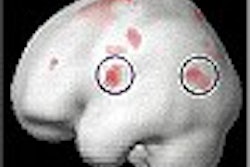SAN FRANCISCO - Fetal MRI continues to improve radiologists' ability to distinguish normal from abnormal fetal anatomy, and consequently treatable from untreatable pathology. At the Society for Pediatric Radiology meeting on Friday, researchers discussed MRI's ability to reliably image the thymus gland at all gestational ages, and its ability to differentiate fetal bronchial obstruction, which has a poor prognosis, from more treatable cystic adenomatoid malformations (CCAM).
Peter Hurh from the Children's Hospital of Philadelphia discussed his group's retrospective review of the thymus in 34 fetal MRI cases ranging in gestational age from 20 to 36 weeks.
"The purpose of our study was to determine the size, shape, extent, and signal characteristics of the normal fetal thymus at different gestational stages," Hurh said.
Imaging was performed using 1.5-tesla MRI scanner (Siemens Medical Solutions, Malvern, PA) equipped with a body array coil. Gradient-echo T1- and HASTE T2-weighted images were acquired using a standard fetal imaging protocol.
Exclusion criteria included multiple pregnancies, oliogohydramnios, fetuses with a space-occupying lesion in the chest, or intrauterine growth retardation.
"We found that the fetal thymus was easily identifiable in all three planes, and we were able to measure the size of the thymus," Hurh said. "On the AP dimension we used either the axial or sagittal view; width was measured using the coronal or axial view."
On coronal views the shape of the thymus was either trapezoidal or oval, and in the sagittal plane its shape was triangular. Depending on the gestational age, the gland could be limited to the upper mediastinum or extend down to the diaphragm.
"We found that on T1 imaging, 100% of the thymus had a greater signal intensity than the lung, and 100% of the thymus had a lower signal intensity than the liver," Hurh said. "And this was consistent across all gestational ages. On T2 we found 100% of the thymus had lower signal intensities than the lung, and higher signal intensities than the liver, and again this was consistent across all gestational ages."
The texture was either homogeneous or demonstrated a fine granular pattern in all cases.
The thymus can be identified on MRI in a wide range of gestational ages, Hurh said, and has characteristic MR features that help differentiate it from abnormal mediastinal masses. The information could be helpful in the diagnosis of an absent thymus, such as in Di George syndrome, he said.
An audience member said that in his experience, hypoplasia is even more common than aplasia in Di George syndrome. Postnatally, the thymus is very difficult to evaluate because it is already shrunken in response to stressful clinical conditions, he said, so fetal investigation of the thymus has important implications.
Fetal bronchial obstruction
In another presentation, Dr. Anne Hubbard, also from the Children's Hospital of Philadelphia, described the appearance of two cases of fetal unilateral bronchial obstruction, and differentiation of the condition from other chest lesions using MRI.
"With primary bronchial obstructions, the entire lung is involved, and there's a high to almost 100% incidence of hydrops," Hubbard said. "Although a lobe may be resected prior to birth, pneumonectomy is not tolerated well in either the fetus or the newborn. The purpose of this study is to describe the MR appearance of fetuses we've seen with unilateral bronchial obstruction, and differentiate these lesions from CCAMs and sequestrations."
Two fetuses were referred with hydrops and an ultrasound diagnosis of CCAM. MRI scans were performed on a 1.5-tesla Siemens scanner using HASTE, FLASH, and EPI sequences, and the results compared to same-day ultrasound.
One fetus was at 18 weeks of gestation, and the other at 21 weeks. In both, MRI showed a large mass of homogeneous signal intensity, with a significant shift of pneumoid structures.
"The first fetus demonstrated dilation of the bronchi out into the mid-portion of the markedly enlarged lung," Hubbard said. There was significant enlargement of the bronchus, which was the same size as the trachea, and no cysts were visible. The second fetus had a very similar appearance, with a large lung lesion and dilated bronchus, she said.
Ultrasound had been equivocal, showing an enlarged echogenic lung, and the distal trachea and bronchus could not be seen. But with MRI it was easy to distinguish bronchial obstruction from CCAM.
While CCAM is often multicystic and somewhat heterogeneous, here the ipsilateral lung was enlarged, Hubbard said, and no normal lung tissue could be identified on the ipsilateral side of the lesion. The contralateral lung was compressed, but had a normal-caliber bronchus.
Both fetuses died, one in attempted in-utero surgery, the other during premature labor and delivery, she said. Pathology, available in one case, showed severe bronchial stenosis with increased size and number of alveoli. Hubbard concluded that prenatal MRI can readily differentiate bronchial obstructive lesions with resulting enlarged lung from other chest lesions.
"It's important to make these differentiations because the outcome is significantly different," she said. "With (bronchial obstruction) there is nearly 100% incidence of hydrops, and fetuses and newborns usually don't tolerate pneumonectomy."
By Eric Barnes
AuntMinnie.com staff writer
May 12, 2003
Copyright © 2003 AuntMinnie.com


.fFmgij6Hin.png?auto=compress%2Cformat&fit=crop&h=100&q=70&w=100)





.fFmgij6Hin.png?auto=compress%2Cformat&fit=crop&h=167&q=70&w=250)











